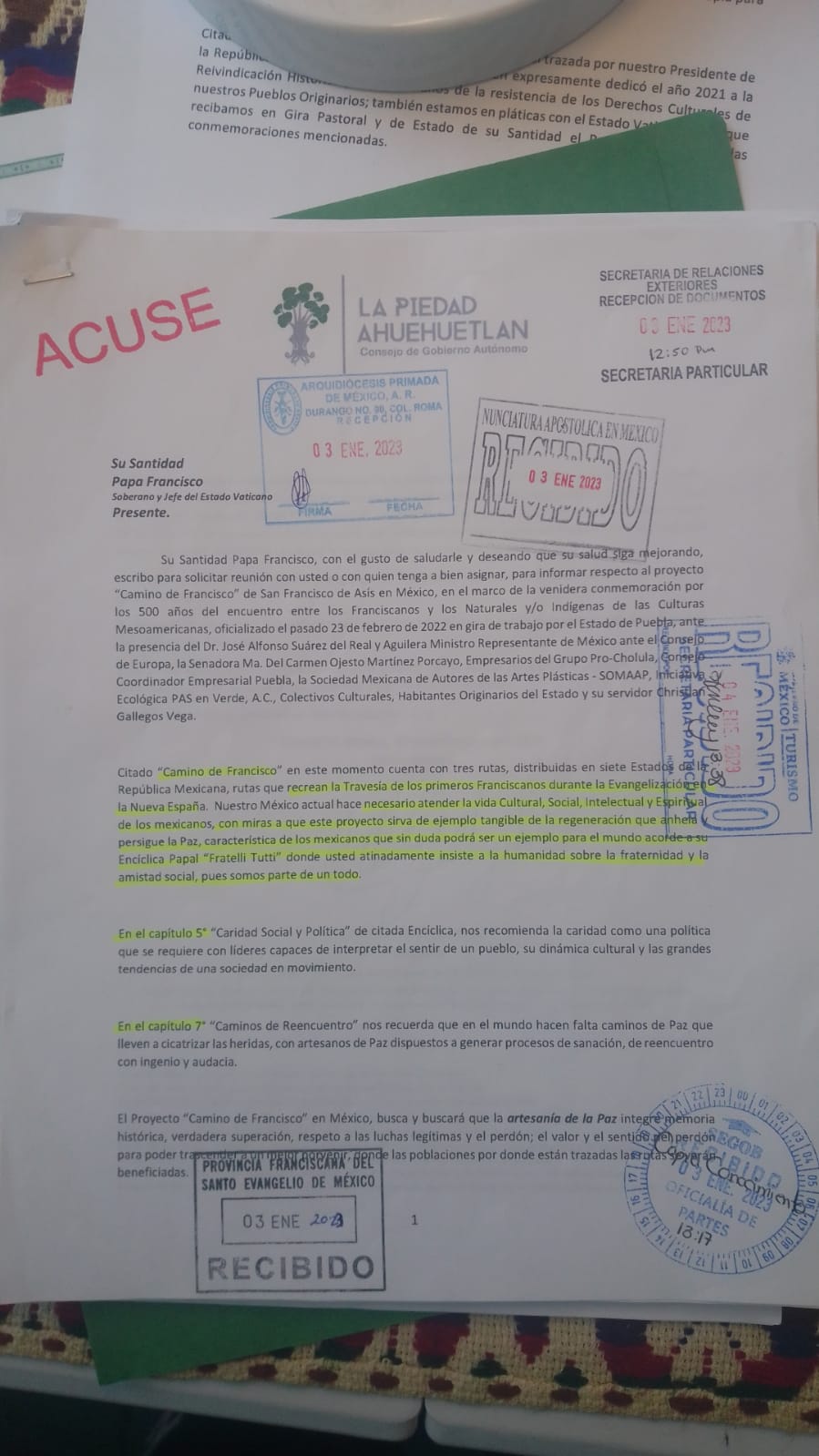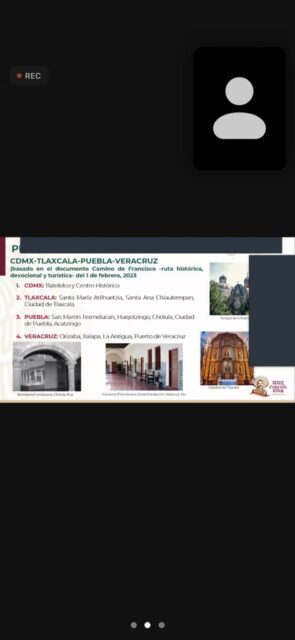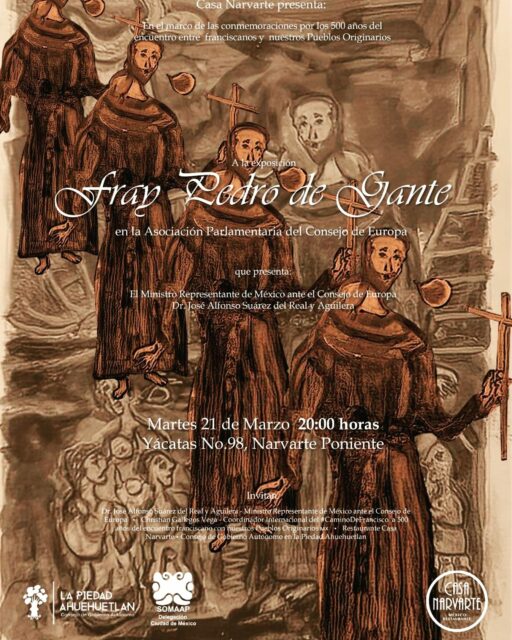Two days ago I received an invitation from Christian Gallegos Vega, president of the Autonomous Government Council of La Piedad Ahuehuetlán, to attend an event. It was the exhibition “Fray Pedro de Gante”, presented by the Minister Representative of Mexico to the Council of Europe, Dr. José Alfonso Suárez de Real y Aguilera. It is an exhibition that takes place in the context of a cultural project proposed by Christian Gallegos, to which José Alfonso Suárez de Real y Aguilera himself would later join. This project is now the object of alleged plagiarism by “some officials of the Ministry of Tourism”, according to what Christian Gallegos told me in an interview, as I describe below.
La Piedad Ahuehuetlán is an urban native town located in the Benito Juárez mayor’s office in Mexico City. Both their ethnicity and the elements that make this people self-identify as “original” have been frequently questioned. The ancestral territory of this town is hidden from the eyes of those who can only see what is apparent, that is, the shopping malls, the multiple sets of rooms (some more luxurious than others) and also the vehicular traffic.
But there are symbolic aspects that characterize the way of life of the inhabitants of La Piedad Ahuehuetlán that require eyes without veils, without dogmas, because as Christian Gallegos Vega, president of the Autonomous Government Council of La Piedad Ahuehuetlán, points out, “talking about native peoples from Mexico City is to speak a new language.”
For La Piedad Ahuehuetlán, being located in one of the most gentrified mayors of Mexico City has represented a constant epistemic struggle to continue existing. The existence of large shopping centers such as Parque Delta should not be recognized as an element that questions their ethnicity or originality (which makes the town original, according to its founding origin, its uses and customs, its way of life and its epistemology).
The construction of stage B of the Parque Delta Shopping Center implied the demolition of the Eighth Police Station, a relevant and appreciated site for its historical and cultural characteristics. It was an Art Deco building, a symbol of modernism in the 40s of the last century, that same place was previously the headquarters of the Imperial College, before the Dominican Monastery and before it was the Sanctuary of the Virgin of La Piedad, which, according to the testimony of Christian Gallegos Vegawas a sanctuary that shared a level of attendance and importance with the Basilica of Guadalupe in the middle of the 18th century.
It was precisely the opposition of the inhabitants of Ahuehuetlán to the construction of stage B of Parque Delta, as well as their impulse to defend a territory that kept historical memories that built the identity of the town, which caused a fight, which I recognize as a fight epistemic. It is epistemic because it defends an original epistemology that confronts a western epistemology in which the territory and human beings are only merchandise.
This would give rise to the configuration of the Autonomous Government Council of La Piedad Ahuehuetlán, among other reasons, to organize as a community, to claim as natives with the aim of defending a territory that still keeps memories of the pre-Hispanic settlement that it was, an issue that materialized when the excavations for the aforementioned construction were carried out and various archaeological pieces integrated with colonial historical foundations were found, among them, a pre-Hispanic jade mask.
Not satisfied with the dispossession of this space, with all the symbolic implications that the case warrants, the president of the Autonomous Government Council of Ahuehuetlán approached me yesterday to inform me that his project entitled “Camino de Francisco (from San Francisco de Asís) 500 years after the Franciscan encounter with our original Mesoamerican Peoples” was threatened by alleged plagiarism by some officials of the Ministry of Tourism. Christian Gallegos Vega thus intends, through this medium, to alert about the alleged plagiarism, based on the awareness of the political actors of Mexico City and the country, regarding the complex realities of the original towns and neighborhoods of the Anahuac, now called Mexico City.

The project in question was conceived and written by Christian Gallegos Vega based on the hypothesis that Juan González y García, a person of great importance for the identity of Ahuehuetlán, was a Franciscan and interpreter of the Guadalupano message to San Juan Diego. According to the information provided in the interview, the traditional authority of Ahuehuetlán mentioned that Juan González lived in Ahuehuetlán in the mid-16th century in the hermitage of visitation, where later in the 17th century the sanctuary of the Virgen de La Piedad was installed, it was much loved in the town and even sponsored certain rituals with the “natives” of the place. That space was sacred since there was a large ahuehuete that emanated from a spring, the ancient inhabitants of Ahuehuetlán came there to ask Juan González and García to help them request the availability of fresh water, because in the face of various modification works In the Anahuac lake landscape, salt water was present in places where fresh water abounded.
In this sense, the aforementioned project intends to commemorate the 500 years of the Mesoamerican meeting and the journey that the Franciscan priests made, notifying the head of the Vatican state and contemplating it on his upcoming state visit. Historical and biographical research on the link between Juan González y García and the Franciscans is pending, but while Ahuehuetlán is directly incorporated into the routes that comprise the project, several have already been defined, both locally, nationally, and internationally. A meeting point within the route is in the Dominican Republic, home of the first Franciscan convent in America, another point of the tour is Colombia, in addition to the different places to visit in Mexico. In our country, the route is contemplated through several states, both in Mexico City, and in Morelos, the State of Mexico, Tlaxcala, Puebla, and Veracruz.
The project arises “in the framework of the commemorations for the 500 years of the meeting between Franciscans and Mesoamerican cultures, the Camino de Francisco contains the cultural, social and spiritual elements necessary to forge artisans of peace and development in the quality of life of tourists, pilgrims and inhabitants”, as referred to in the document written by Christian Gallegos for the presentation of the project.
In the words of the president of the Autonomous Government Council of Ahuehuetlán, it is about giving new meaning to spirituality to claim the identity and permanence of the native peoples and neighborhoods. This is based on the recognition of religious syncretism between the original and the Catholic, with all the complexities of history, understanding that although the Catholic religion was an ally through evangelization campaigns so that the Spanish could consolidate their invasion, it has also been one of the elements that defines and governs life in the original towns and neighborhoods of Mexico City, which has contributed to their permanence despite repeated attempts at ethnocide, this has been achieved, among other aspects, from their different ways of exercising their popular religiosity.
The project was presented by Christian Gallegos Vega in the company of Senator Carmen Ojesto on January 4, 2023 to the Federal Secretary of Tourism, who was pleased and the meetings began via Zoom; It is in the meeting on Friday, February 10, 2023 at 11 in the morning via Zoom that lower-level officials of the Secretary of Tourism presented the same content to officials from the States of Veracruz, Puebla and Tlaxcala and the same proposals in the that they omitted the corresponding credits making it appear that said project is governmental.



Christian Gallegos has understood this situation as a “modern conquest”, which from sociology we can enunciate as neocolonialism, or even as internal colonialism, only at a different geographical level than that addressed by Rodolfo Stavenhagen and Pablo González Casanova, to whom it is attributed said concept. But above all it is about the dispossession on the dispossession, that is, a first spatial dispossession on which Parque Delta was built and a second dispossession in terms of the historical memory that said place keeps, as well as the third dispossession (through the presumed plagiarism) of a project that aims to rescue said historical memory to vindicate the original peoples and neighborhoods of this city in other international spaces, in order to achieve a gradual change of conscience in terms of the recognition of the epistemological diversity that only the original peoples make possible. .
So far the project has not been implemented, which is why Christian Gallegos Vega alludes to an alleged plagiarism, but for now the way in which native peoples are dispossessed of their territories, their cultures and even from his historical memories. In the words of Christian Gallegos Vega, traditional authority of the town of La Piedad Ahuehuetlán: “The original peoples are not opposed to working with the government of the mayors, nor with that of Mexico City, we simply ask that all officials and the three levels of government respect the customary law of us the peoples of Anahuac”.
* I appreciate the comments and recommendations of the Anthropologist Sofía Huerta Noguera. At the same time, I acknowledge the revision and additions made to this article by the president of the Autonomous Government Council of La Piedad Ahuehuetlán.
Interview with Christian Gallegos Vega, president of the Autonomous Government Council of La Piedad Ahuehuetlán, conducted by Fernanda Isabel Lara Manríquez on March 22, 2023, via Google meet.
Quoted interview.
Interview with Christian Gallegos Vega, president of the Autonomous Government Council of La Piedad Ahuehuetlán, conducted by Fernanda Isabel Lara Manríquez on June 9, 2022. In La Piedad Ahuehuetlán, Benito Juárez, Mexico City.
To deepen theoretical aspects of epistemic struggles, I suggest reading Rosalba Icaza and Rolando Vázquez, entitled “Social Struggles and epistemic struggles” in Development and Change 44(3):683-704. International Institute of Social Studies. USES. John Wiley & Sons.

